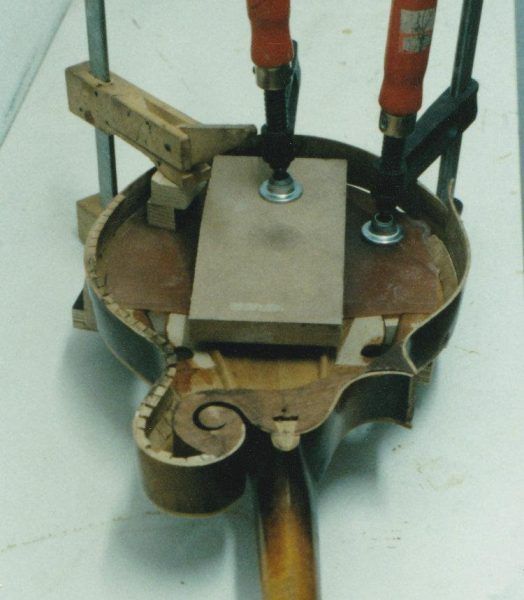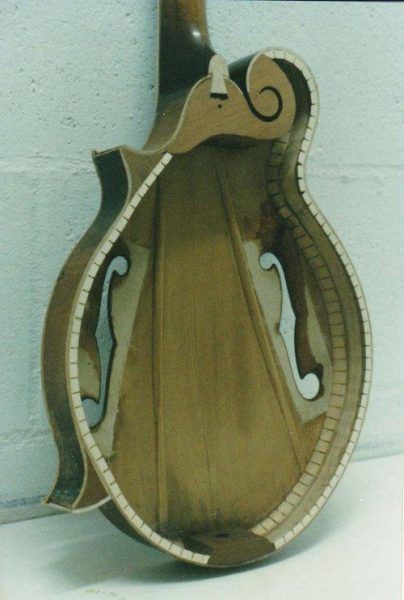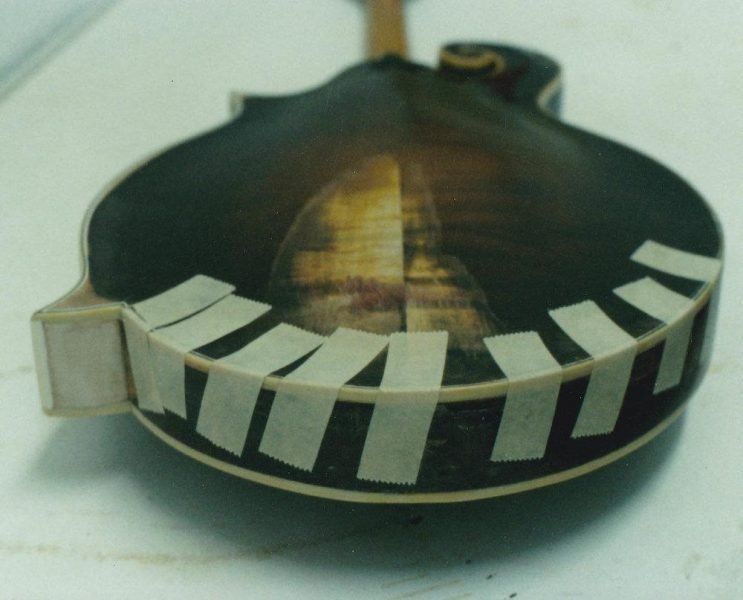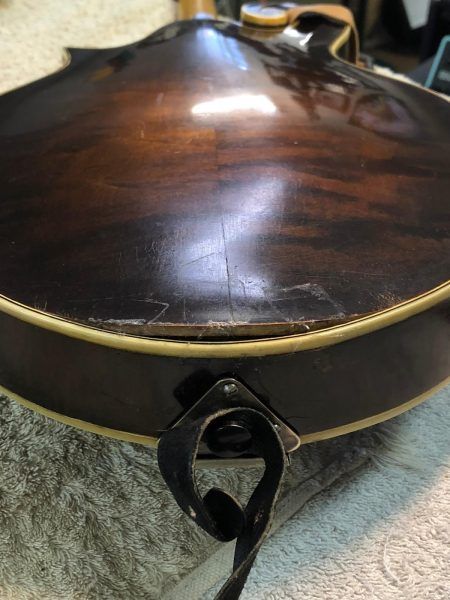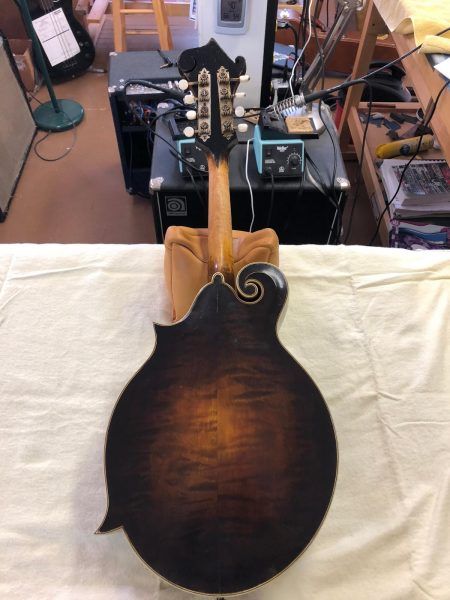The Loar
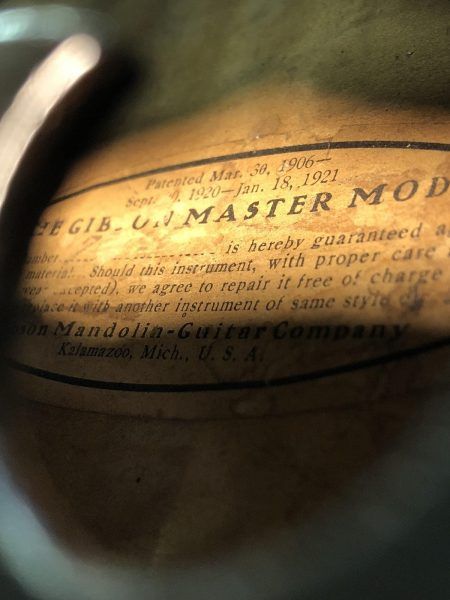
To quote Michael Wright of Vintage Guitar Magazine, “There are bad accidents and there are good, or “happy” accidents.
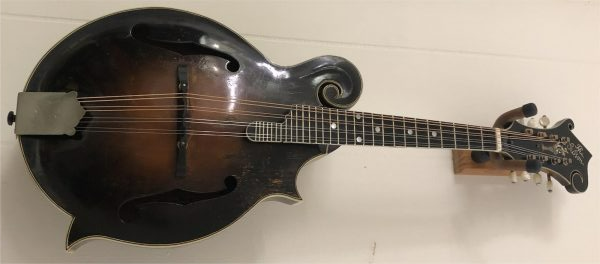
Bad ones are when you bend over, your rear-end knocks over your axe, and suddenly you’ve “created” a headless guitar. An example of a happy accident is the invention of the Alvarez Dana Scoop.” Another example of a happy accident is finding a Gibson F-5 mandolin in an old barn that was signed by Lloyd Loar on February 18, 1924..
-Discovering a “Relic”
As reported by Gilchrist Mandolins & Guitars, this Gibson Master-Model F-5 Mandolin was found in the mid 90’s “wrapped in plastic, in its case and stored outdoors for years”. Identified by its factory order number (11965) the life of this F-5 started in 1923 at the original Gibson factory in Kalamazoo, MI. All wood pieces (Top, Back, Sides, & Tone Bars, F Holes) were carefully handcrafted by Gibson’s luthiers under the watchful eye of Loar. Each piece was then tap-tuned by Loar and paired with pieces that would produce a perfectly harmonious frequency. Loar adapted Stadivarius’ technique of “Plate-tuning” (tap-tuning) each piece in perfect harmony, ultimately providing an instrument with more volume and better freq. balance. Today(2019) tap-tuning plays a major role in acoustic guitar manufacturing. Without the creation of Loars Master Model Series instruments, more specifically the F-5 Mandolin (& L-5 Guitar), todays “Sound-Box” instruments might have a different voice. Of the (311) F-5 mandolins that have passed through the hands of Loar in his first floor laboratory at 225 Parsons st. this mandolin is (1) of (247) recorded by Daryl Wolfe (Wolfes F5 Journal).
-Restoring a piece of history
Recently DSR, INC, Master Luthier Dana Sutcliffe had the unique pleasure of restoring an instrument known as the “Holy Grail” of mandolins, a 1924 Master Model F-5 Gibson Mandolin, signed February 18, 1924 by, none other than, Lloyd Loar.
The damage looked obvious, as the back soundboard was coming apart from the heel and binding, as well as cracks starting at the tail guard screws. But to understand what was creating the issue we needed to see what was happening on the inside. For this task a high definition borescope made it simple for Master Luthier Sutcliffe to identify that defective adhesive was allowing the back soundboard to peel apart from the heel block and was starting to expose the Kerfling. And upon further review, the top soundboard was separating from the sides/heel block, the back soundboard center seam was starting to separate, the fret board was severely damaged w/ binding falling off, and the frets were in terrible shape. All things considered this repair was now a restoration and we had to make plans for our new guest.
First step in repairing the bonding issues, was designing a custom jig and clamping system for securing areas needing bonding with an even amount of tension Then after cleaning and prepping each interior area Master Luthier Sutcliffe applied protocol specific adhesive from inside the instrument while monitoring his progress via borescope. As soon as the curing process was completed it was on to the fingerboard.
The fingerboard and frets showed a lot of wear, which was great to see as this means the current owner is an active player. Loar would be pleased. Nonetheless this part of the restoration required securing the binding, carefully removing the frets, planing and slotting the fingerboard. The customer chose a player specific fret size for installation. Prepping frets for installation includes measuring, cutting, and bending fret wire by hand so all 20 frets, plus 9 on the tongue, to match the fingerboard radius for a safe and secure installation. As soon as the 29th fret was installed Master Luthier Sutcliffe resecured neck binding to Loar’s protocol.
-The “Loar” - Protocol
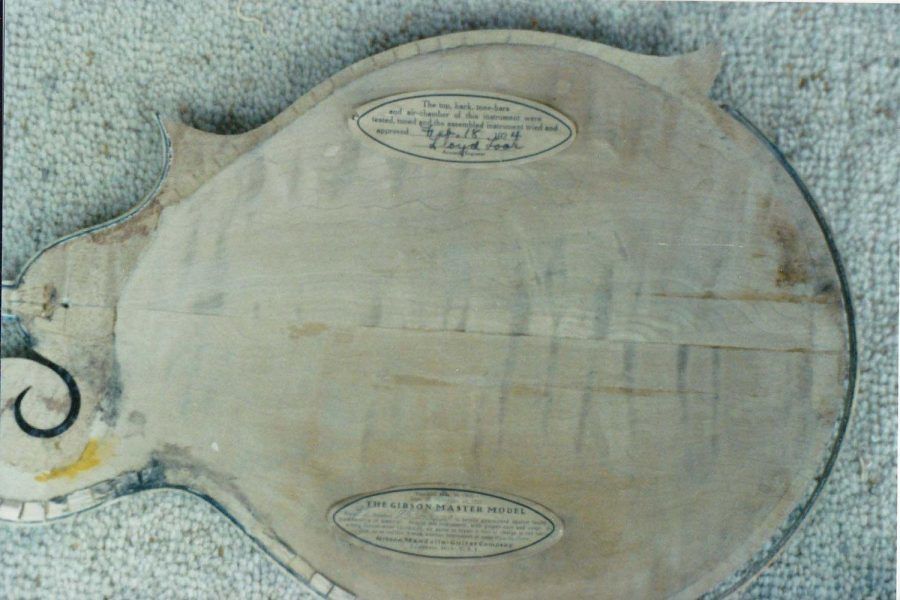
In 1918 on the first floor of 225 Parson rd, The Gibson Co. witnessed the introduction of an iconic new mandolin that featured among other things a longer neck with 12 frets clear of the body, violin style f-holes, a distinctive shaded ‘Cremona’ finish and most importantly “Plate-Tuning” (aka “Tap-Tuning”) which would change the protocol of how Gibson instruments would be made for years to come. Under the scientific guidance of Lloyd Allayre Loar, soundboards and backboards for Gibson’s Master Model mandolins, mandolas, and guitars were carefully graduated from their thickest to their thinnest regions. For mandolins, this called for soundboards and backboards to be carved to about .110″ in the thinnest or- “minimum area” (about 1″ in from the perimeter) and about .180″ at the center. Since these components were later “tuned,” the final thickness would differ from instrument to instrument depending on the stiffness of the wood, grain distribution, density, etc. Soundboards were also arched to give them strength. The graduation from the center outwards provided for a means of efficient distribution and transfer of energy (from the bridge outwards). This carving technique, often called “Stradivarius arching,” allowed the soundboard and backboard to “pump” like the paper cone of a common speaker, generating greater compression and rarefaction within the instrument’s air chamber; a movement that provided theses instruments with greater amplitude then their former counterparts. Longitudinal tone bars were also “tuned” by thinning them to adjust the stiffness of the soundboard. The bass bar and treble bar were positioned in a non-symmetrical manner, and sized differently so that the treble side and bass side of the soundboard could be separately adjusted (i.e. the two tone bars were not symmetrically positioned). By removing wood from the tone bar, the soundboard would become less stiff, resulting in a lowered pitch. By tuning the tone bars to a specific note, Gibson engineers could be assured of likewise adjusting the soundboard to a known and very repeatable stiffness. The tuning process is so controllable that a whole-tone difference could be attained between the two tone bars. As a final tuning step, the f-hole openings were also “tuned”. To do this, the size of the f-holes was adjusted after the instrument was assembled, to achieve the final tuning of the instrument. As the f-holes were made wider (larger), the pitch of the air chamber would be raised until the proper note was achievable. Loar followed the teachings of Hermann L. F. Helmholz (1821-1894) who studied the resonant frequencies of variously sized air chambers. Loar carefully sized the air chambers and f-holes of the instruments he designed to provide a correctly tuned space for each type and size of instrument. Since an adjustment to one part of the instrument effects the tuning of another part, one can appreciate the hours of trial and error that preceded the development and subsequent finalization of the dimensions of Gibson’s “Master Model” instruments. As final proof of the hand-tuning process, Loar gave his signature on a label inside the instrument attesting that “The top, back, tone-bars, and air-chamber of this instrument were tested, tuned and the assemble(d) instrument tried and approved ___(date)___.” (Siminoff, Instrument Design)
-Restoring History - Cont.
Once the restoration process was complete it was time to level, crown, and polish the frets for balance string frequency and no string buzz. Removal and replacement of the existing nut which included leveling the nut slot and hand crafting a new bone nut. Installation of new D’Addario EJ75 strings, carving string slots to support the gauge of each string and correct placement of the bridge (13-15/16”) for accurate intonation. The current book value on this F-5 is $156,000 while street value is almost as high as $175,000.
This has been one of the utmost wonderful restoration experiences we at DSR, INC have had the pleasure of completing. Our goal at DSR, INC is to preserve the history of every instrument within its original design protocol.
____________________________________________________________________________
- Wright, M (2010, January). ‘The Alvarez Dana Scoop’. Vintage Guitar, vol. 24, no. 03.
- Gilchrist, S (2016) Gibson F5 Mandolin #75325. Retrieved from https://www.gilchristmandolins.com/75325-restore
- Siminoff, R (2014) Loars Contributions To Instrument Design. Retrieved from Https://www.siminoff.net/loars-contributions/

